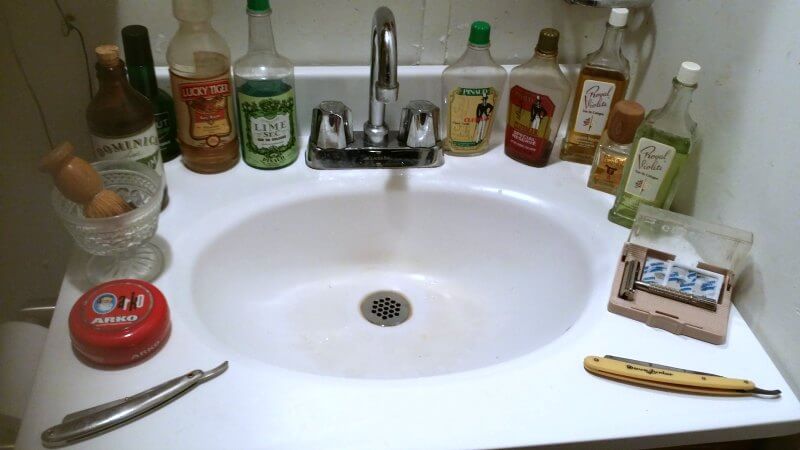
What You May Not Know About Your Favorite Splash
In the modern world, for most of us, shaving is a daily ritual. We hardly even think about it anymore. In fact, the modern cartridge razors (that have more blades on them than my lawnmower) have just about turned shaving into a quick, mindless activity. The same for electric razors. But, there are still many of us who go the extra-mile to get a real shave, and enjoy the look and feel of a perfectly groomed face. One of the more important tools to accomplish this is aftershave lotion.
What Is Aftershave?
Aftershave is a lotion or balm applied to the face after shaving to moisturize, tighten, and sterilize your facial skin. Shaving is not a natural function, and it can be hard on your face, which is somewhat more sensitive than other areas. Scraping your face with a super-sharp (we hope…) blade, or series of blades does some damage to the top layer of skin, from abrasions, cuts, friction, or any combination of the three. This is also true for electric razors.
Aftershaves were created to prevent infection from this damage. In the olden days, this was a major concern because, before antibiotics, and antiseptics, you could die from simple infections. So, a modern aftershave contains at least three separate components. The first, and most important, is an antiseptic. The most common is some form of alcohol, but stearate, citrates, and Witch Hazel are also used. These work by killing surface bacteria before they can get into a cut, or through open pores. The next component is a moisturizing agent. Shaving soaps and creams can dry out your facial skin, and make it feel very uncomfortable after a shave. Dry skin also does not look good. Common moisturizers are Shea Butter, Kokum Butter, Cocoa Butter, Olive Oil, Coconut Oil, etc….These all do a great job of keeping your skin looking fresh and healthy. The last component, and least important, is fragrance. However, fragrance is the reason most men buy a particular aftershave, and there is nothing wrong with that. Use what you like. Common fragrances are essential oils and herbs like bay leaves, rum, sage, lavender, lilac, citrus, and more.
Why Use Aftershave?
There are some men who do not like aftershave, because the alcohol-based lotions can sting and burn, but this is why aftershave is so important. The stinging means you have tiny cuts and abrasions, and the alcohol is sterilizing them. Aftershave balms have less (or no) alcohol, more Witch Hazel and moisturizers in them, and really leave your skin feeling and looking great. If you have never tried an aftershave balm, you should, at least once.
You should always use some kind of aftershave, regardless of how you shave. Ingrown hairs, and infected cuts are not attractive, and dry skin looks dull and unhealthy.
In The Beginning…
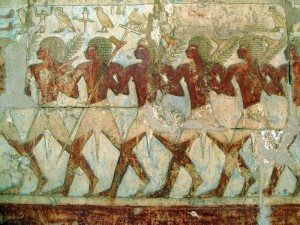
The ancient Egyptians pioneered the use of essential oils and other scents around 4000 years ago, but it was to cover up body odor, rather than any hygienic purposes. It started as a way to make the chore of mummifying dead bodies a little less unpleasant. Later, it was found to work equally well on live bodies, and women especially became fond of using what would become perfumes1.
Things stayed that way until the Romans created the division of labor that we recognize today, where everyone has a trade. One of the trades they created was the professional barber, who also was responsible for shaving their customers, many of whom were Legionnaires and soldiers. The Romans were the first military unit in the world to require troops to be clean shaven and short-haired, because it was discovered that when bearded and long-haired troops faced you, such as Greeks2, it was not that hard to grab a handful of hair and beard, twist, and break a neck or two. So the Roman army kept their barbers busy. Barbers soon discovered that some of their customers developed infections after being shaved. While they may not have known much about germ theory back then, they could still add two and two. They discovered that they could make a plaster from herbal components that seemed to lessen the problem3.
A Legend Is Born…
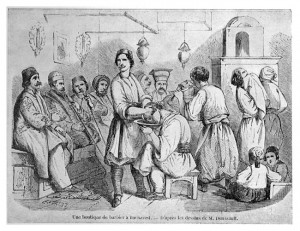
During the Victorian Era, scented waters such as Rose, and Orange water were used to cover up body odors and soothe the skin. But infections from shaving were still a problem. In 1822, Louis Pasteur discovered that infections were caused by microscopic lifeforms he called, “germs”, and that alcohol, and some other compounds seemed to kill them4. The stage was set.
In 1830, the Hungarian Cavalry was very busy, spending long months in the field far from the attentions of barbers, yet regulations required the men to be very clean shaven. Skin infections were a very real problem for them. A well-known perfume and cologne maker from Paris, Edouard Pinaud was contacted to see if he could come up with something to make life a little more pleasant for these hard-working troopers. This resulted in the creation of one of the first, longest-lived, and best loved men’s fragrances commercially available…Lilac Vegetal5. It could be used both as an aftershave, and a body splash between baths, and was wildly successful, so much that it is still in production today, over 150 years later. There are many that dispute the story, but the fact is that Napoleon III granted the title of Royale Parfumer to Pinuad soon after, so Edouard must have done something extraordinary. The rest of Europe soon followed and aftershaves became very popular with men from all walks of life6.
The State Of The Lotion…
Today, you can get a decent aftershave for a few dollars, or spend a small fortune on boutique blends. It’s up to you. Price is not necessarily an indicator of quality as far as aftershaves go. There are outstanding aftershaves for a modest price, and absolutely horrible ones that cost more than a bottle of 20 year-old single-malt scotch. Over the years, a few have stood out:
Lilac Vegetal
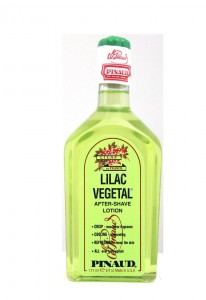
Already discussed, this enduring aftershave has a crisp feel to it with the floral aroma of lilac. The modern version does have some chemically off-scents to it, but these can be alleviated by leaving the bottle open for a few days to let the chemicals evaporate, leaving just the wonderful original scent. Some love it, others hate it. But one thing that can’t be dismissed…it’s been a good seller for over 150 years so they must be doing something right.
Bay Rum
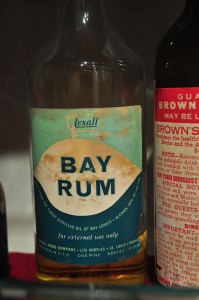
One of the all-time classic barber shop fragrances. Created in the 1870s, it was a modern distillation of an essence made by Islanders in the Virgin Islands, who steeped island bay leaves in rum, added some citrus, cloves and cinnamon, and used it as a splash tonic. A Danish chemist living in St. Thomas, Albert Riise, discovered a way to double-distill the essence, creating a vastly superior product, and thus, Bay Rum was born. It won the prestigious Centennial Award in Philadelphia in 1876, as well as many others all over the world, and was proclaimed as the absolute best men’s fragrance ever created. During WW-II, for several reasons, Bay Rum declined in popularity, mostly due to unavailability, and all but disappeared. But in 1946, a US Navy man, John Webb, decided to revive the scent while stationed at the Submarine Base in St. Thomas. He started the West Indies Bay Company, and began producing St. Johns Bay Rum aftershave, the Big Kahuna of Bay Rums, still in production. Many other companies now produce Bay Rum aftershaves and colognes, but St. Johns is considered the real deal. With wonderful aromas of light rum, cinnamon, citrus, and bay leaves, it is little wonder that it is has been one of the most loved aftershaves by many men, including this author.
Brut
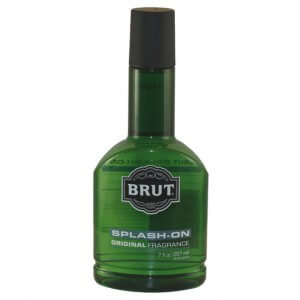
Created in 1963 by Fabergé. It was marketed as a boutique-scent, but by 1968, a somewhat diluted version was made available as a budget aftershave under the name Brut 33, meaning it was 33% the strength of the original. The 33 version was much more popular than the original, and was/still is used by many famous people. When Fabergé. was taken over by Unilever in 1989, the name was changed back to Brut Classic. With aggressive masculine scents of sandalwood, lavender, oak moss and jasmine, it is one of the most popular modern men’s fragrances available. Almost every man has probably used Brut at one time of another, and for many of us, it was our first aftershave.
Taylor Of Bond Street
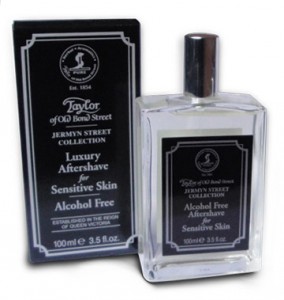
In 1834, Jeremiah Taylor opened up his hair salon in London’s upscale West End district. He quickly gained a reputation for creating top quality herbal hair tonics and aftershaves. Over the years, the company expanded and today, Taylor Of Bond Street products are available all over the world. These are high-end luxury products, and many of the fragrances they market are available nowhere else. They have a very loyal following.
Lucky Tiger
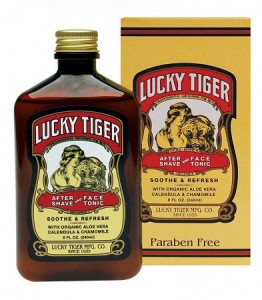 Another of the all-time classic barber shop products, Lucky Tiger began in the 1920s, in the barber shop basement of Ben Clarke, in Wichita, Kansas. He wanted to create a superior product to what was then available, and he called his lotion Lucky Tiger. He made versions for hair and scalp treatment, and also a version that was intermediate between aftershave lotion and aftershave balm, with the best qualities of both. It quickly became a hit, and people came from all over the country to get the royal treatment from Clarke…shave and a haircut…2 bits (25¢), and a generous splash of his lotions (now you know where that little ditty came from. It was Lucky Tigers radio advertisement)… He sold them from his shop but the demand quickly overwhelmed his ability to supply. In 1930, he trademarked the name and had it produced commercially. The rest, is history. Today, you can still get his original formula, with great fragrances of orange, tangerine and grapefruit, and the health benefits of aloe vera, calendula, chamomile, and borage oil to soothe your sensitive skin. They also market a version of Bay Rum, and a spicy, outdoorsy fragrance called Aspen. Although seldom seen in modern Barber Shops and stores, Lucky Tiger products can be purchased online from their website.
Another of the all-time classic barber shop products, Lucky Tiger began in the 1920s, in the barber shop basement of Ben Clarke, in Wichita, Kansas. He wanted to create a superior product to what was then available, and he called his lotion Lucky Tiger. He made versions for hair and scalp treatment, and also a version that was intermediate between aftershave lotion and aftershave balm, with the best qualities of both. It quickly became a hit, and people came from all over the country to get the royal treatment from Clarke…shave and a haircut…2 bits (25¢), and a generous splash of his lotions (now you know where that little ditty came from. It was Lucky Tigers radio advertisement)… He sold them from his shop but the demand quickly overwhelmed his ability to supply. In 1930, he trademarked the name and had it produced commercially. The rest, is history. Today, you can still get his original formula, with great fragrances of orange, tangerine and grapefruit, and the health benefits of aloe vera, calendula, chamomile, and borage oil to soothe your sensitive skin. They also market a version of Bay Rum, and a spicy, outdoorsy fragrance called Aspen. Although seldom seen in modern Barber Shops and stores, Lucky Tiger products can be purchased online from their website.
Using aftershaves will make your skin look and feel better after your shave. Find one you like, and do your mug a favor.
Citations
Manniche, Lise: Sacred Luxuries: Fragrance, Aromatherapy and Cosmetics in Ancient Egypt (Cornell University Press, 1999)
http://www.todayifoundout.com/index.php/2013/04/the-history-of-shaving/
Andrews, William, The Sign of the Barber’s Pole: Studies in Hirsute History (Illustrated Edition) (Dodo Press) William Andrews (Dodo Press, 2009) 90 pages. Lethe Press Paperback 108 pages ISBN 978-1-59021-081-9
- Rothman, Irving N.”The Reliable Barber Supply Co.: An Annotated Chronological Bibliography of the Barber—Second Delivery.” Bulletin of Bibliography 55.2 (1998): 101-21 [186 items.] ISSN 0190-745X
- https://pomadeshop.com/en/brands/clubman-ed.-pinaud/410/lilac-vegetal-after-shave
- http://ed-pinaud.com/en/history/

Someone must be from S. Florida, or so it seems from the first picture above! The Royal Violets baby Cologne is the quintessential Cuban baby fragrance, but older men and some male teenagers have been known to use it as aftershave or after bath splash in the evening. It’s a lovely fragrance and there is nothing “baby” about it!
-Gil
Found this on Lucky Tiger’s website:
“The story of Lucky Tiger has been handed down from generation to generation. As it is now told, the Lucky Tiger legend began in the 1920’s, in Kansas City, Missouri, in the basement of Benjamin Clarke…”
I’ve been able to find no other citations verifying either Wichita or Kansas City.
Clubman would’ve been a good one for the list, but due to space limitations, I had to focus on the ones with interesting stories behind them. I’ll try to do a feature on Clubman and some other popular aftershaves next time around.
My uncle Fred turned me on to “The Veg” when I was a teenager. It was interesting at first, but proved to be far too strong (and unusual) for me in the long run.
But I’m a bit surprised the classic Pinaud Clubman aftershave isn’t mentioned here. http://www.amazon.com/Clubman-Pinaud-After-Shave-Lotion/dp/B000053L6Y
This is the scent I associate with the barber shops of my youth. I don’t use scents very often, but this is one I splash on occasionally—when I’m felling really “old school”.
Comments are closed.